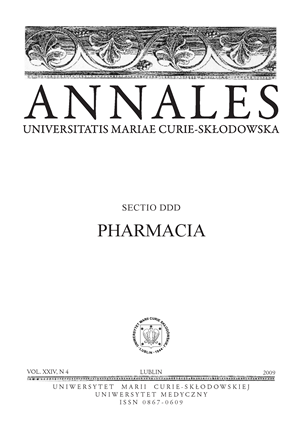Wpływ jonów Cu2+ i Zn2+ na oddziaływanie chinidyny, dizopiramidu i metoprololuz melaniną in vitro
Abstrakt
Wiązanie leków do melaniny może mieć istotne farmakologiczne konsekwencje. Pomimo wielu badań dotyczących natury wiązania leków do melaniny dokładny mechanizm tego oddziaływania pozostaje nieznany. Celem pracy była analiza oddziaływania leków antyarytmicznych z melaniną w obecności jonów miedzi i cynku. Stwierdzono, że analizowane leki tworzą kompleksy z biopolimerem melaninowym. Ponadto wykazano, że jony Cu2+ i Zn2+ wbudowane do melaniny przed tworzeniem kompleksów z lekami zmniejszają całkowitą ilość chinidyny, dizopiramidu i metoprololu związanych z melaniną.
Bibliografia
1. Abraham D. J.: Burger’s Medicinal Chemistry and Drug Discowery. 6th Edition, Vol. 3: Cardiovascular Agents and Endocrines, John Wiley @ Sons, Inc., 2003.
2. Binns F., Chapman R. F., Robson N. C. et al.: Studies related to the chemistry of melanins. Part VIII. The pyrrolecarboxylic acids formed by oxidation or hydrolysis of melanins derived from 3,4-dihydroxyphenethylamine or (±)-3,4-dihydroxyphenylalanine. J. Chem. Soc. C, 1128, 1970.
3. Buszman E., Różańska R.: Interaction of quinidine, disopyramide and metoprolol with melanin in vitro in relation to drug-induced ocular toxicity. Pharmazie, 58, 507, 2003.
4. Cheong H. I., Johnson J., Cormier M., Hosseini K.: In vitro cytotoxicity of eight betablockers in human corneal epithelial and retinal pigment epithelial cell lines: comparison with epidermal keratinocytes and dermal fibroblasts. Toxicol. In Vitro, 22, 1070, 2008.
5. Formigari A., Irato P., Santon A.: Zinc, antioxidant systems and metallothionein in metal mediated-apoptosis: biochemical and cytochemical aspects. Comp. Biochem. Physiol. C, 146, 443, 2007.
6. Kalbitzer H. R., Stehlik D.: On the analysis of competitive binding of various ligands to cooperative and independent binding sites of macromolecules. Z. Naturforsch., 34c, 757, 1979.
7. Larsson B. S.: Interaction between chemicals and melanin. Pigment Cell Res., 6, 127, 1993.
8. Meredith P., Sarna T.: The physical and chemical properties of eumelanin, Pigment Cell Res., 19, 572, 2006.
9. Pollak P. T.: Clinical organ toxicity of antiarrhythmic compounds: ocular and pulmonary manifestations. Am. J. Cardiol., 84, 37R, 1999.
10. Prota G.: Melanins and Melanogenesis. Academic Press, London 1992.
Pobrania
Opublikowane
Numer
Dział
Licencja
Prawa autorskie (c) 2009 Autorzy

Praca jest udostępniana na licencji Creative Commons Attribution-NonCommercial-NoDerivatives 3.0 Unported License.


